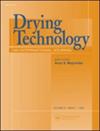木材干燥过程中的内应力发展:主曲线概念及其在干燥应力评价中的应用
IF 2.7
3区 工程技术
Q3 ENGINEERING, CHEMICAL
引用次数: 0
摘要
摘要采用在线恢复力(RF)技术,研究了半裂矩形木材试样在干燥过程中平切和四分之一锯橡胶木板内应力(IS)的产生。特别关注的是最长的IS逆转机制。平锯试件的IS发展速度快于四分之一锯试件,但两种试件的最大IS强度相当相似。通过对IS反转周期进行归一化,提出了一个主IS曲线,即测量射频对IS反转时间比的导数与IS反转时间比的导数。这条主曲线在一定程度上不受木材取向和干燥温度的影响,其变化与湿区和干湿区组分的自由含水量相关。IS的逆转过程不受暂时不受约束的影响,随着干区向内扩展而推进,并在湿区消失时结束。假设干区和湿区之间的力学平衡,可以从射频数据中估计两个区域的IS。干燥区的最大拉伸IS(表明表面检查的风险)在较高的干燥温度下以略低的幅度演变,并且在四分之一锯试件中较低。在没有施加RF的情况下,干区IS的松弛仍然主要发生,这突出了干/湿区分数的主要贡献,继续不受限制地进行IS的发展。这些发现强调了干湿带的重要性,为更好地理解木材干燥过程中IS的发展铺平了道路。关键词:干燥应力应力反向干湿区机械平衡橡胶木材披露声明作者声明他们没有利益冲突。本研究由泰国科学研究与创新和瓦莱拉克大学资助(批准号:RSA6180077)。本文章由计算机程序翻译,如有差异,请以英文原文为准。
Internal stress development within wood during drying: A master curve concept and its application on drying stress evaluation
Abstract The generation of internal stress (IS) in flat-sawn and quarter-sawn rubberwood boards during drying has been investigated using an online restoring force (RF) technique, which restrained a half-split rectangular wood specimen. Particular attention was given to the longest IS reversal regime. The IS development proceeds faster in the flat-sawn specimens than that in the quarter-sawn specimens while the maximum IS magnitudes in both specimens are rather similar. By normalizing the IS reversal period, a master IS profile, the derivative of the measured RF to the IS reversal time ratio versus the IS reversal time ratio, is proposed. This master curve, exhibiting some degree of independence from wood orientation and drying temperature, shows variations correlated with the free water content in the wet zone and the dry/wet zone fractions. The process of IS reversal, unaffected by temporary unrestraint, advances as the dry zone expands inwards and ends when the wet zone disappears. Assuming mechanical equilibrium between the dry and wet zones, the IS in both zones can be estimated from the RF data. The maximum tensile IS in the dry zone, indicating a risk of surface checks, evolves at slightly lower magnitudes at higher drying temperatures and is lower in the quarter-sawn specimens. The IS relaxation in the dry zone, still largely taking place in the absence of the applied RF, highlights the main contribution of the dry/wet zone fractions, continuing to proceed without restraining, to the IS development. These findings, emphasizing the significance of dry and wet zones, should pave the way for a better understanding of the IS development within wood during drying.
求助全文
通过发布文献求助,成功后即可免费获取论文全文。
去求助
来源期刊

Drying Technology
工程技术-工程:化工
CiteScore
7.40
自引率
15.20%
发文量
133
审稿时长
2 months
期刊介绍:
Drying Technology explores the science and technology, and the engineering aspects of drying, dewatering, and related topics.
Articles in this multi-disciplinary journal cover the following themes:
-Fundamental and applied aspects of dryers in diverse industrial sectors-
Mathematical modeling of drying and dryers-
Computer modeling of transport processes in multi-phase systems-
Material science aspects of drying-
Transport phenomena in porous media-
Design, scale-up, control and off-design analysis of dryers-
Energy, environmental, safety and techno-economic aspects-
Quality parameters in drying operations-
Pre- and post-drying operations-
Novel drying technologies.
This peer-reviewed journal provides an archival reference for scientists, engineers, and technologists in all industrial sectors and academia concerned with any aspect of thermal or nonthermal dehydration and allied operations.
 求助内容:
求助内容: 应助结果提醒方式:
应助结果提醒方式:


